Sturgeon River, Ontario, Canada
August 4 - 10, 2000
This is the story people find most fascinating because itinvolves serious injury far from medical attention. The plan was to flyto aremote location in the Tamagami region, then paddle back tocivilization inseven days. The plan did not include Rob breaking his wrist on thethird dayand my resultant transformation into wilderness doctor and adventureracer inthe triathlon from hell. This was the only wilderness trip I have evertakenwith just one companion and it dramatically illustrates why that is ariskyproposition.
Friday, Aug. 4
The drive from Cincinnati to London, Ontario.
I left home at 4:30 p.m. to meet Rob who was running late from abusiness trip to Greensboro, S.C. He arrived at his house around 5:15and we finally departed around 5:45. Rob was delayed when his planeneeded a tire change and was further frustrated by a traffic jambetween the Cincinnati airport and Hamilton. We followed the usualroute north on I-75, but intended to take a different route across intoOntario at Detroit. There was an extraordinarily long line of trafficwaiting to cross the bridge into Windsor when we finally reachedDetroit around 10:00. In frustration, Rob pulled out of line and headedfor the only other crossing, the tunnel. We soon discovered that thetunnel was closed due to some sort of emergency and that allinternational traffic was being rerouted. So, we opted to head northfor Port Huron, Michigan hoping for less traffic and a faster crossing.The crossing at Port Huron was indeed quick and easy and we drove onthrough the night, arriving at London, Ontario around 1:00 a.m. We soonlocated a Comfort Inn with vacancy and settled for the night.
Saturday, Aug. 5
The drive to Tamagami and bush plane flight to Scarecrow Lake.
We were up at 5:30 a.m.—a beautiful sunny day—and grabbed breakfaston the run at Tim Horton’s. Traffic was terrible through Toronto andnorth on the freeway. Finally, we escaped most of the traffic and foundourselves ahead of schedule. 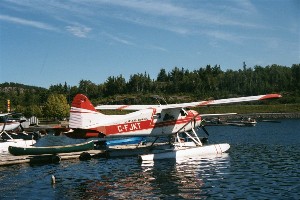 As we neared the townof Orilla, Rob insisted on buying beer, so we wasted a half-hourdriving around looking for a beer store. Once Rob made his purchase, Itook over driving responsibilities so he could imbibe. At North Bay, westopped for dinner at an Italian restaurant before resuming the drivenorth. We reached the village of Tamagami and the Lakeland Airways baseat 3:15 and were soon unloading the van and preparing to board theaircraft. The aircraft was a vintage 1956 Beaver with three seats andenough room for our gear, with the canoe strapped to a pontoon. Ourpilot, Chris, seemed very young.
As we neared the townof Orilla, Rob insisted on buying beer, so we wasted a half-hourdriving around looking for a beer store. Once Rob made his purchase, Itook over driving responsibilities so he could imbibe. At North Bay, westopped for dinner at an Italian restaurant before resuming the drivenorth. We reached the village of Tamagami and the Lakeland Airways baseat 3:15 and were soon unloading the van and preparing to board theaircraft. The aircraft was a vintage 1956 Beaver with three seats andenough room for our gear, with the canoe strapped to a pontoon. Ourpilot, Chris, seemed very young.
Our flight lasted around 40 minutes before Chris made a smoothlanding on the lake. We quickly unloaded our gear into the canoe,disconnected from the plane, and waived to Chris as he took off andleft us alone on Scarecrow Lake at 4:30. We were not exactly alone,because two other paddlers had been dropped off earlier that day andthey now inhabited the island campsite we had hoped to secure. 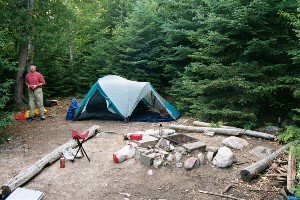 We paddled near the island, wavedto the guy we could see at the water’s edge and then paddled backtoward the northeastern end of the lake where there was supposed to beanother campsite. We soon located a reasonably good site back in thetrees and set about establishing our camp. We were near a trail leadingto the highest point in Ontario, but neither of us felt ambitiousenough to hike for 3 hours, so we made a fire and enjoyed cocktail hourand then dined on freeze-dried chicken-ala-king and garden peas. It wasa beautiful evening and we were amazed at the lack of bugs—a majoradvantage of canoeing in August instead of June.
We paddled near the island, wavedto the guy we could see at the water’s edge and then paddled backtoward the northeastern end of the lake where there was supposed to beanother campsite. We soon located a reasonably good site back in thetrees and set about establishing our camp. We were near a trail leadingto the highest point in Ontario, but neither of us felt ambitiousenough to hike for 3 hours, so we made a fire and enjoyed cocktail hourand then dined on freeze-dried chicken-ala-king and garden peas. It wasa beautiful evening and we were amazed at the lack of bugs—a majoradvantage of canoeing in August instead of June.
Sunday, Aug. 6
Scarecrow Lake; Woods Lake; Little Scarecrow Lake; Hamlow Lake; thenightmarish Stull Creek; Sturgeon River; campsite on Paul Lake.
We were up at 7:00 a.m., excited to be on our way. There was no rainor wind, but the sky was cloudy and threatening. Rob had lost his spoonthe night before and was facing a week in the wilderness without theprimary utensil. Fortunately, I spied it between the logs of thedilapidated logging dock as I turned from doing the morning dishes inthe lake. Rob was greatly relieved and, of course, acknowledged that hewas very much in debt to me.
We headed out into Scarecrow Lake around 9:30 and soon paddled pastthe island, waving once again at the two guys camped there. We paddledour way on through a narrow swift into Woods Lake where we saw andheard numerous loons. A short and easy 140-meter portage took us intoLittle Scarecrow Lake. This portage gave us our first opportunity totry out my new portage device, the Knu-Pac Frame. I purchased it at thelast moment as a precaution against further injury to my right shoulder(injured practicing a kayak Eskimo roll). The device worked much like abackpack frame in that it transferred the weight of the load, in thiscase the canoe, from the shoulders to the hips and lower body. Inparticular, it is designed to alleviate the severe shoulder and neckpain usually associated with portaging a heavy canoe. Even with theframe, my Old Town Tripper is very sobering when its 80+ pounds arehoisted on your body, but the frame helped significantly, makingportaging an issue of leg muscle strength, balance, and aerobicendurance rather than pain tolerance. Unfortunately, Rob could notadjust to the new system and acquired some bruises on his sides whilemaking the effort. He later determined that the real issue was just theimmense weight of the canoe coupled with the challenging terrain we hadto traverse.
At the west end of Little Scarecrow Lake, we had to pull the canoeover an old log dam and proceed through a narrow and shallow streambefore coming out into Hamlow Lake. To get from Hamlow to the SturgeonRiver, we had three choices: 1) a three mile portage over an oldlogging road; 2) a 165-meter portage plus an 1875-meter portage throughswamps and a burned out area; or 3) paddle and trek along Stull Creek,known to be impassible during low water and described by one writer as“nightmarish.” We chose the creek.
Initially, we had some difficulty locating the creek because we werelooking in the wrong marshy area. Finally, we located it where a largelogjam necessitated a slippery portage/pull-over. Once we hadtransported all of our gear to the other side, we were pleased to seethat the stream, although only 6 – 10 feet wide, was navigable. Atleast it was navigable in places. It took us from 12:30 to 4:30(including a lunch break) to reach the Sturgeon River. Travel on thecreek was very strenuous—intermittently trudging over unmarkedportages, furiously pulling the loaded canoe over rocks and logs,wading through swift waist-high water, lining the canoe through shortdrops and narrow rapids. At one point, Rob slipped and fell downpainfully hard on his tailbone.
At about 2:00, we stopped on some rocks for lunch at a place wherethe creek flowed over a razor-sharp rock ledge into a pool three feetbelow. 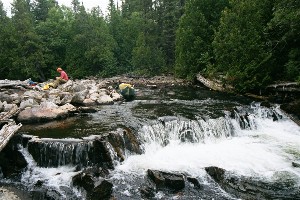 We took our time andenjoyed our typical lunch of cheese and crackers. We were justfinishing up when the two guys who had been camping on the islandshowed up. We conversed briefly in the way of wilderness canoeists whoare somewhat distressed to find others intruding into their solitude.They were both from Toronto (we later learned their names were Matt andBrad) and they paddled a light Scott kevlar canoe that they werecareful to protect from the sharp rocks. We watched them pass out ofview as the rain began to fall. The rain continued intermittently therest of the day. At last we made it to the Sturgeon River and it beganto rain very hard. Rob and I both enjoyed the beauty and challenge ofthe creek, but it was a relief to be on the wider river where it waspossible to just paddle without having to wade, push, and pull.
We took our time andenjoyed our typical lunch of cheese and crackers. We were justfinishing up when the two guys who had been camping on the islandshowed up. We conversed briefly in the way of wilderness canoeists whoare somewhat distressed to find others intruding into their solitude.They were both from Toronto (we later learned their names were Matt andBrad) and they paddled a light Scott kevlar canoe that they werecareful to protect from the sharp rocks. We watched them pass out ofview as the rain began to fall. The rain continued intermittently therest of the day. At last we made it to the Sturgeon River and it beganto rain very hard. Rob and I both enjoyed the beauty and challenge ofthe creek, but it was a relief to be on the wider river where it waspossible to just paddle without having to wade, push, and pull.
We caught up with the Toronto guys one more time before they onceagain paddled on ahead of us into Paul Lake around 5:30. We let them goon ahead on this large elongated lake and instead searched forcampsites along the eastern rock bluffs. We settled on a site 15 feetabove the lake with a great view. It was a bit of a climb to reach thesite, but well worth the effort. Due to the rain, we immediatelyerected the rain tarp on ropes between the trees and started a goodfire beneath. We enjoyed cocktail hour as always and dined on Cajunchicken with rice and green beans. It rained all night.
Monday, Aug. 7
Ghoul Lake; portage to Twin Falls; Eaglenest Lake; Lyman Lake;difficult portage around Kettle Falls; rapids, falls, and portages;campsite on Perkins Lake.
We awoke at 7:30 a.m. to overcast skies. It sprinkled, then pouredas we made breakfast under the tarp and wearily began to break camp.From Paul Lake we paddled to the southeast through a beautiful narrowswith rocks mirrored clearly on the unruffled water. The sun beganpeaking through the clouds, slowly burning off the mist. As wasfrequently the case on this trip, both of us commented on the amazingbeauty of this area. There were more varieties of plants and trees thanwe were used to seeing on our western Ontario trips and the highgranite cliffs and hills added a scenic touch.
We ran some minor rapids into Ghoul Lake, another beautiful lakedespite its name. A 250-meter portage awaited us at the end of the laketo the right of the river’s entrance to Twin Falls. Camped at the headof the trail were Matt and Brad who had elected to sleep in due to theinclement weather. I tried the Knu-Pac frame with both the canoe and areasonably heavy pack, weight of perhaps 140 pounds. It was impossiblyheavy, especially given the wet, rocky, and precipitous terrain of thetrail (typical terrain for this trip as it turned out). Soon I stoppedand waited for Rob to come to my assistance, dropping the heavy packand proceeding ahead with the canoe. That was the last time I attempteda double carry.
To my chagrin, I now realized that we had packed too much gear, orat least we had not packed the gear we had in an efficient manner. Wehad the canoe, 4 large heavy portage packs and then the miscellaneousitems like paddles, pfd’s, and miscellaneous bags to carry. We werehaving to make three trips down and back on each portagetrail—extremely inefficient and time consuming. I eventually ended upcarrying 2 of the large heavy packs at the same time to avoid the extratrip down each trail, but it made for tough going.
After reloading the canoe, we paddled out to see Twin Falls, animpressive sight. 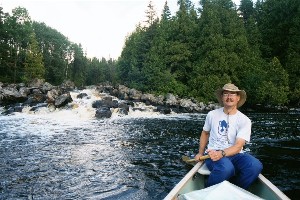 We took a couple of pictures, had abrief snack, and then pushed on down river. We ran a number of easyrapids and continued to enjoy the scenery as we came out and passedthrough Eaglenest Lake, essentially just a widening of the river. Atlast we came to a 130-meter portage on the left around rapids and alogjam. It probably would have been runable but for the logjam. Robagain tried the Knu-Pac frame and struggled with it before finallycarrying the canoe part way using the old unpadded yoke on the canoe.Rob was in some pain from the fall he had taken yesterday, plus he nowhad sore ribs from the Knu-Pac frame, sore feet from the rocks, and arash caused by a bad reaction to “Bite-Eze,” a bug bite remedy that hehad found lying on the ground along the portage trail.
We took a couple of pictures, had abrief snack, and then pushed on down river. We ran a number of easyrapids and continued to enjoy the scenery as we came out and passedthrough Eaglenest Lake, essentially just a widening of the river. Atlast we came to a 130-meter portage on the left around rapids and alogjam. It probably would have been runable but for the logjam. Robagain tried the Knu-Pac frame and struggled with it before finallycarrying the canoe part way using the old unpadded yoke on the canoe.Rob was in some pain from the fall he had taken yesterday, plus he nowhad sore ribs from the Knu-Pac frame, sore feet from the rocks, and arash caused by a bad reaction to “Bite-Eze,” a bug bite remedy that hehad found lying on the ground along the portage trail.
As we continued on downstream and into the afternoon, we sufferedthrough intermittent heavy rain showers and sprinkles. We managed toavoid a short portage by running the small class II rapid there and weended up running numerous class I rapids after that before the riverslowed down at Lyman Lake where we stopped for lunch on a rockypromontory. At the end of the short and narrow lake, we came to the 345portage to the right of Kettle Falls. Given our success with rapids onthis day, we did paddle over to scout the drop, but it was asignificant waterfall and there was no alternative to the portage. Wehad good reason to avoid this portage. I knew from my research that itwas a killer. Kevin Callan, in his book Further Up the Creek, describesit as follows:
The Kettle Falls portage is insane. It is only 345 meterslong, but you have to be half mountain goat to survive it. First youhave to climb almost straight up from the take-out . . . then wanderaimlessly up on top in search of the correct trail that will eventuallylead down an even steeper slope to reach the put-in.
Mr. Callan’s description is grossly understated. While not as severeas the Diablo Portage on the Steel River, it easily takes second placeand is the most difficult portage of that length I have experienced.The difficulty of traversing this narrow, rain-soaked trail up and overan immense irregular granite bluff carrying heavy unbalanced loadscannot be adequately explained to the uninitiated. Rob later confessedto me that he did not believe the two of us could possibly make it overthis trail with all of our gear.
Taking a deep breath, I hoisted a heavy pack and grabbed whateverelse I could carry and began the slippery ascent. 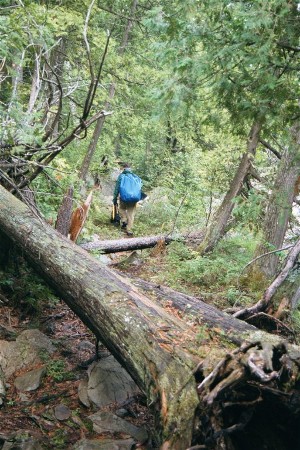 Somewhere along the trail, Robbecame lost. I didn’t see him behind me and was afraid he might havefallen. I shouted, but received no response. I continued to the end ofthe trail, dropped my packs, and returned back to the canoe. I didn’tsee Rob again until I completed my second trip across with anotherpack. He had just completed his first trip after becoming lost and hadotherwise had a tough time getting over the trail. Only one pack plusthe canoe remained, so we went back again grimly determined to get thecanoe over the trail. This was where I realized the extraordinarybenefit of the Knu-Pac frame. I ended up carrying the canoe over theentire trail unaided. At critical moments, I was able to keep my handsfree to hold on to the granite or assist in balancing. Instead ofenduring intense shoulder and neck pain, I was able to concentrate onbalance and use leg strength and endurance to keep going. Rob wasamazed at the fete I had accomplished and, frankly, so was I.
Somewhere along the trail, Robbecame lost. I didn’t see him behind me and was afraid he might havefallen. I shouted, but received no response. I continued to the end ofthe trail, dropped my packs, and returned back to the canoe. I didn’tsee Rob again until I completed my second trip across with anotherpack. He had just completed his first trip after becoming lost and hadotherwise had a tough time getting over the trail. Only one pack plusthe canoe remained, so we went back again grimly determined to get thecanoe over the trail. This was where I realized the extraordinarybenefit of the Knu-Pac frame. I ended up carrying the canoe over theentire trail unaided. At critical moments, I was able to keep my handsfree to hold on to the granite or assist in balancing. Instead ofenduring intense shoulder and neck pain, I was able to concentrate onbalance and use leg strength and endurance to keep going. Rob wasamazed at the fete I had accomplished and, frankly, so was I.
We paddled a short distance before coming to the next portage of 190meters on the left. After scouting, we ended up lining the canoe overthe first ledge, then running the balance of the rapid. We also managedto avoid the next portage of 105 meters by running it. However, thenext portage of 130 meters had to be taken around a substantialwaterfall. It was at this portage that our Toronto friends finallycaught up with us. 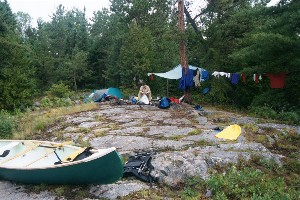 We talked with them for awhile,with the main topic of conversation being the hellish Kettle Fallsportage. We completed the portage around 7:30 p.m., pushed out intoPerkins Lake, and took the first campsite we could find on the leftside of the narrow lake. Matt and Brad soon followed and found a sitenearly across from us on the right side of the lake.
We talked with them for awhile,with the main topic of conversation being the hellish Kettle Fallsportage. We completed the portage around 7:30 p.m., pushed out intoPerkins Lake, and took the first campsite we could find on the leftside of the narrow lake. Matt and Brad soon followed and found a sitenearly across from us on the right side of the lake.
We set up camp around 8:00 in the drizzle, erected the rain tarponce again, and managed to start a modest fire. Dinner consisted ofSierra Chicken, corn, and booze. Then we wearily retired to the tent.
Tuesday, Aug. 8
Hazel Lake; rapids and portages; Rob breaks his wrist; tough solopaddling and portaging; late dinner under a tree in the rain.
We arose around 8:00 a.m. It was cloudy, but no rain yet. We werevery slow about breaking camp. We saw Matt and Brad start out at leastan hour and a half before we were ready. Rob seemed to be particularlysore and weary. His various maladies, especially his sore feet, weretaking a toll. His neoprene water shoes had almost no support orpadding in them and only a modest amount of tread. It was a little likewearing bedroom slippers over sharp rocks. His only other pair of shoeswas a very worn pair of tennis shoes reserved for around the camp.However, given the severity of the portage trails, he had determined towear the tennis shoes from now on. This resolution was soon abandonedwhen he slipped and fell hard just walking through the campsite. Itturned out that the tennis shoes had less traction than the water shoesand were virtually bald. I too had suffered wearing my water shoes,although my shoes were much better than Rob’s. Today, I donned myhigh-top Bean boots for their added support and traction.
At last we had the canoe loaded and Rob had reluctantly put his wetshoes back on. We paddled to the end of the lake to the first ofseveral daunting portages. This one was 265 meters on the left side,running along the river. We ran a few short rapids and crossed anothersmall lake, Hazel Lake, before unloading again for a 100-meter portageon the left. None of these portages were easy, but they were certainlynot as bad as yesterday’s goat trail. We paddled on for about 4 miles,running a few class I rapids before coming to the next portage, 160meters on the right around violent rapids and waterfalls. This wasanother typical rough, wet, and slippery trail featuring, among otherobstacles, a slippery granite face with especially precariousfootholds. We completed the portage without incident and Rob went backfor the last pack. I waited at the bottom of the slippery granite facewith my camera hoping to snap a picture as he struggled down the hill.When he finally came over the rise, he did not have the pack and washolding his arm in an odd manner. As I snapped the picture, he calledout to me that he had broken his wrist.
I could hardly believe it, and he was clearly shocked at the notionas well, plus dealing with significant pain. 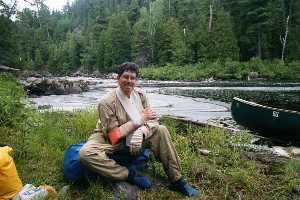 He had gone back along the trail to get the pack, nothing in his hands,and had slipped on a rock, breaking his backward fall with his rightarm. I sat him down on one of the packs and examined his right wristand lower arm. It was obviously broken and dislocated. I got out thefirst aid kit, read the instruction book, and applied a splint, usingan ace bandage to bind it tight. I used another bandage and a safetypin to improvise a sling for him. I was primarily concerned about thecirculation in his hand and the pain. I had him take 4 ibuprofenimmediately.
He had gone back along the trail to get the pack, nothing in his hands,and had slipped on a rock, breaking his backward fall with his rightarm. I sat him down on one of the packs and examined his right wristand lower arm. It was obviously broken and dislocated. I got out thefirst aid kit, read the instruction book, and applied a splint, usingan ace bandage to bind it tight. I used another bandage and a safetypin to improvise a sling for him. I was primarily concerned about thecirculation in his hand and the pain. I had him take 4 ibuprofenimmediately.
It was only now dawning on me that he would not be able to assist inportages and that he would not be able to paddle or do a hundred otherthings that hadn’t even occurred to me yet. After getting himcomfortable, I returned for the last pack. Then we discussed ouralternatives. The most important factor was time. It was important toget Rob back to civilization as quickly as possible to minimize hisdiscomfort and also because we couldn’t be sure how serious the injurywas and what complications might ensue. We couldn’t go back becausethere was nothing to go back to. We couldn’t sit and wait for rescuebecause we didn’t know who might come along and whoever did come alongprobably couldn’t get to help any quicker than we could. I could leaveRob behind and try to get help on my own, but I would still have toportage the canoe and some gear and I would have to go without benefitof the tent, a serious consideration given the rain and bugs. We couldabandon some of the gear and try to speed our progress, but most of thegear was pretty essential and Rob’s condition didn’t seem to warrantextreme measures. In any event, it would undoubtedly take a couple ofdays at least to reach any vestige of civilization. Our itinerarycalled for a minimum of 4 and a half days more paddling and portagingto get back. Based upon my newfound confidence in the Knu-Pac frame andin my own conditioning, I told Rob that I felt confident of getting himout in not more than 3 days. Rob deferred to me on this, so I decidedto push from dawn until dark each day until we reached help. We beganimmediately.
I loaded the canoe and got Rob aboard. He was a little tentative atfirst because his arm became more painful if he leaned over and it wasalso more difficult for him to balance on the ubiquitous slipperyrocks. It was also difficult for him to sit helplessly by as I didvirtually everything from portaging to paddling to opening and closingcontainers for him. I paddled a short distance and then unloaded for ashort 85-meter portage on the right around more falls. A couple ofmiles later, I stopped at a campsite on an unnamed lake where we hadlunch. Some of the realities of being one-handed became clear to Robduring lunch as he found he could not get out of the canoe if the bankwas too high or slippery and he couldn’t open packs or open hispocketknife or effectively open any food packaging or slice cheese,etc., etc. It was very frustrating for him and I had to keep remindingmyself to help him with things that both of us normally took forgranted.
After lunch, which was around 3:00, I paddled a few miles down riverand ran a few easy rapids before arriving at the next portage of 105meters. 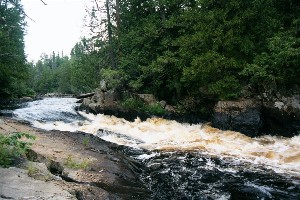 I scouted the class II-III rapidfrom the trail. There was a beautiful campsite just above the rapidsfrom which I could thoroughly examine the water pattern. I decided itwas runable. I made sure Rob’s pfd was as secure as possible despitehis inability to fit one arm through and I asked him to hold the paddlein his good hand in case he had an opportunity to fend off a largerock. It was big water and required some deft maneuvering among thesubmerged boulders, but we made it through unscathed except for thecold water that splashed over the gunwales onto my patient. I waslikewise able to avoid the next 50 meter portage by running the rapidand ran a few other easy rapids along the way, stopping occasionally tobail the water out.
I scouted the class II-III rapidfrom the trail. There was a beautiful campsite just above the rapidsfrom which I could thoroughly examine the water pattern. I decided itwas runable. I made sure Rob’s pfd was as secure as possible despitehis inability to fit one arm through and I asked him to hold the paddlein his good hand in case he had an opportunity to fend off a largerock. It was big water and required some deft maneuvering among thesubmerged boulders, but we made it through unscathed except for thecold water that splashed over the gunwales onto my patient. I waslikewise able to avoid the next 50 meter portage by running the rapidand ran a few other easy rapids along the way, stopping occasionally tobail the water out.
Unfortunately, we could not run the serious rapids and waterfallsrunning through a narrow gorge and were forced to take the verydifficult 450-meter portage on the right. Doing all the portaging wasdefinitely tough. I had to make 4 back and forth trips for each portagecarrying the maximum load I could tolerate. Rob would carry somemiscellaneous gear for the first trip, and then follow me back toassist my getting the canoe on the frame and then walk behind me as Icarried the canoe doing his best to encourage my progress. By the timeI completed the 450-meter portage, I knew my leg muscles were becomingover-stressed and weary. I tried to keep myself hydrated and to eatenough high-energy food.
A short time later, I paddled up to another portage, this time 280meters on the right and again the rapids and falls could not be run. Bythe time I finished this portage, which culminated in a steep 10-footdrop at the end, it was after 7:30 and I was becoming catatonic. Thisportage was followed almost immediately by another of 156 meters on theleft side of the river. After scouting the somewhat challenging classII rapid, I decided I could run it, but I was undoubtedly influenced inpart by the lateness of the day, my weariness, and the dread of takinganother portage. It was a tough run and we did hit one large rocksolidly, but I managed to pull the canoe through the last wave as therain began to fall and my watch showed 8:30 p.m.
Not far down river, we located a campsite and I wearily unloaded thecanoe and began to set up the tent in the growing darkness andincreasing rain and biting insects. It was tempting to just go to bedwithout eating or to just eat cold snack food, but I resisted thetemptation. Rather than set up the rain tarp, we huddled on the groundbeneath a tree for shelter and I boiled water on my small stove andmade dinner. I don’t remember what we ate, but I remember thinking thateven under these seemingly adverse conditions, I still liked being outhere and still enjoyed the experience. We made it to the tent by 11:00and Rob tried to position himself and his arm for what he hoped wouldbe a good night’s sleep. At least the ibuprofen, aspirin, and alcoholhad helped dull the pain.
Wednesday, Aug. 9
Encounter with Matt and Brad; Upper Goose Falls; Obabika River;encounters with summer camp groups; campsite at the end of the ObabikaPortage.
My alarm was set for 6:00 a.m. and I immediately got up and beganthe task of boiling water for coffee and getting things organized andpacked. To my surprise as well as Rob’s, he was actually able to getsome sleep during the night. The broken arm had hurt some and he hadbeen somewhat uncomfortable, but it had not been as bad as we hadanticipated. We broke camp and pushed off in our loaded canoe by 8:30.Everything was taking longer with only one of us able to do most of thework. I didn’t even take a photograph of the campsite, a very unusualomission for me. We paddled across the small lake formed at the mouthof the gorge beyond which we could hear the roar of the falls. 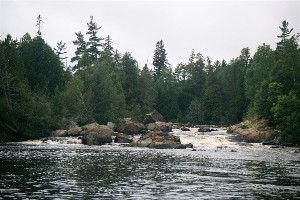 I expected to find Matt and Bradcamped near the falls at the other end of the 265-meter portage and Iwas not disappointed in that regard. I walked out of the woods with myheavy packs onto the gravelly alluvial beach right behind Matt who wasbrushing his teeth. The two Canadians were a bit shocked at our newsand, of course, sympathetic. They were traveling very light and did noteven have a first aid kit with them, so serious physical injury wasclearly something they had never contemplated. They were kind enough toassist me with the final packs, a gesture I sincerely appreciated.
I expected to find Matt and Bradcamped near the falls at the other end of the 265-meter portage and Iwas not disappointed in that regard. I walked out of the woods with myheavy packs onto the gravelly alluvial beach right behind Matt who wasbrushing his teeth. The two Canadians were a bit shocked at our newsand, of course, sympathetic. They were traveling very light and did noteven have a first aid kit with them, so serious physical injury wasclearly something they had never contemplated. They were kind enough toassist me with the final packs, a gesture I sincerely appreciated.
Although we were pushing on ahead of them, I figured they wouldcatch us and pass us sometime during the day, so I merely asked them tonotify anyone they encountered that we were in need of medicalassistance. They agreed and also offered to help us along the way andwe discussed a few other alternative rescue plans. Then Rob and Iclimbed into the canoe and paddled off around the river bend, stoppingbriefly to purify some drinking water. As it turned out, we did not seethem again. We were apparently pushing too long and hard to allow themany reasonable chance of catching us.
We made very good time, running every rapid the river threw at us,and must have covered 12 to 15 miles before 1:00 p.m. 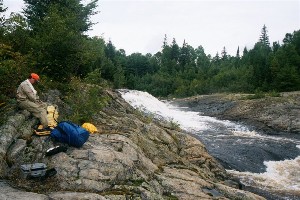 At last we arrived at Upper GooseFalls, a short 80-meter portage around a very dramatic waterfall. Aftercompleting the portage in the light rain, I joined Rob on the rocksoverlooking the falls for lunch. There was a very nice scenic campsiteat the top of the falls and I suspected Matt and Brad would camp therewhen they arrived. In fact, under normal circumstances, this would havebeen our destination for the day. Instead, we packed up the canoe andshoved off into a very swift current, running a series of rapids that,according to the literature, was class II, but didn’t seem all thatsignificant when compared to some of the stretches we had already run.
At last we arrived at Upper GooseFalls, a short 80-meter portage around a very dramatic waterfall. Aftercompleting the portage in the light rain, I joined Rob on the rocksoverlooking the falls for lunch. There was a very nice scenic campsiteat the top of the falls and I suspected Matt and Brad would camp therewhen they arrived. In fact, under normal circumstances, this would havebeen our destination for the day. Instead, we packed up the canoe andshoved off into a very swift current, running a series of rapids that,according to the literature, was class II, but didn’t seem all thatsignificant when compared to some of the stretches we had already run.
The topography below the falls changed dramatically as the rivercrashed off the Canadian Shield leaving all the granite behind and wefound ourselves surrounding by high sandbanks and gravel bars. After 2miles of paddling, we came to a large sandbank on the left side wherethe Obabika River flowed into the Sturgeon. It was here that we were toleave the Sturgeon and head northeast up the Obabika River towards thebigger lakes where we expected to find motor boats and perhapscottages. The route was not an easy one, however. It started with a975-meter portage and then entailed paddling against the swift currentfor many miles while facing numerous logjams, beaver dams, and othernatural impediments. Initially, the portage was pretty severe. Itwandered through a boulder garden, then through the sand along theriver, then entered the woods over fallen logs and up and down steepembankments for a short distance before going straight up the sandembankment about 20 feet. Upon struggling up the embankment, I had tofall to one knee and roll the pack’s weight forward to avoid pitchingbackwards over the precipice. When I tried this with the canoe, itslipped from the frame and pinned me on the edge until Rob came up tohelp extricate me.
Upon reaching the top of the embankment, the trail was adream—straight and flat following the riverbank. There were no rocksand very few obstacles, just soft sandy soil covered with pine needles.The portage was necessitated by the numerous waterfalls and rapids inthe river along this stretch. At the end of the portage trail was aflat area suitable for camping and an old abandoned 5’ x 5’ hut thatonce had been fully screened. There was a rough atv trail leading in,obviously for fisherman access, but there was no evidence of recenttravel. On my second trip back along the trail I encountered a group ofcanoeists portaging in the opposite direction, i.e. down river. It wasa boy’s summer camp group out of Algonquin. I discussed the route aheadwith the group leaders and considered alternate routes they suggested.Essentially, they were of the opinion that I could not possibly make itup the river without another paddler and that I might be better offgoing with the current down the Sturgeon. However, after reviewing thetopographic maps, they had to agree that there really was no viablealternative to my original plan.
As I headed back down the portage trail again with the final packs,it began to thunder and rain very hard. I was soon soaking wet. To myastonishment, another group of summer campers came down the trail, thistime an all girl group that had been out canoeing for 28 days straight.It seemed to be a pretty hardy bunch. When I got back to the campsite,Rob mentioned that one of the members of the group, a 14 year old girl,had broken her wrist 2 weeks ago and was wearing a cast. She wasinterested to see that Rob had the same type of splint that she had hadand was otherwise interested to know what had befallen him. Rob wassomewhat consoled to find that this young accident victim was back onthe trail again immediately after her mishap.
We endured one more downpour before attempting to put up the tentand otherwise put things in order. Rob and I had a discussion aboutwhether to push on up the river immediately in an attempt to reach thelogging bridge that the two summer camp groups had mentioned to us. Itwas around 5:30 and we had at least 3 hours of light left. I knew Robwanted to push on in the hope of quickly finding the bridge and somesort of rescue. We also smelled a skunk periodically and Rob wasfearful that it lived nearby and might arbitrarily spray us just tomake our lives more miserable. I did not share Rob’s skunk phobia andwas not restrained in my ridicule. I did have other concerns, however.We did not know how far the bridge was or how swift the current mightbe. I was unwilling to risk being caught out on the river after darkwithout a place to camp and, besides, I was physically exhausted fromthe paddling and especially from the long portage I had just completed.Rob reluctantly resigned himself to another night in the woods.
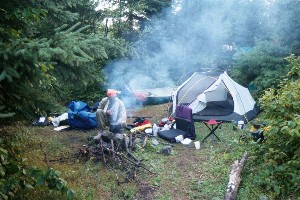 So, I put up the tent and set aboutdoing all the other routine chores, including stringing up ropes andhanging out wet clothing, while Rob attempted to stoke the fire, adifficult job given all the recent rain. Eventually, the fire tookhold; we boiled water, and dined on chili mac with beef, plus peas. Itwas a pleasant evening without rain and the fire and firewater madeeverything seem better. We knew tomorrow would be our last day on theriver. We would definitely find a way out via the logging road or oneof the large lakes that lay ahead.
So, I put up the tent and set aboutdoing all the other routine chores, including stringing up ropes andhanging out wet clothing, while Rob attempted to stoke the fire, adifficult job given all the recent rain. Eventually, the fire tookhold; we boiled water, and dined on chili mac with beef, plus peas. Itwas a pleasant evening without rain and the fire and firewater madeeverything seem better. We knew tomorrow would be our last day on theriver. We would definitely find a way out via the logging road or oneof the large lakes that lay ahead.
Thursday, Aug. 10
Upstream on the Obabika River; rescue at the logging bridge; thefishing camps; retrieval by plane; the emergency room in North Bay andthe drive south.
We rose at 6:00 a.m. again. It was a beautiful, clear morning, mistrising from the river at the touch of the sun. We broke camp, loadedthe canoe, and pushed off, headed upstream. The current was fairlystrong and I had to paddle hard and relentlessly to keep our momentumgoing forward. To complicate things, there were occasional deadfallsand logjams to work around. In places, the current was funneled througha narrow space or over rocks, and it was almost too swift to negotiate.For that reason, we climbed out of the canoe wherever it was shallowenough and would push or pull the canoe forward, sometimes up to ourwaists in the cool water. We made better time this way than if I hadsimply tried to paddle through. Also, I knew I would have to reserve myenergy, because we might have to continue up the river for severalhours before finding help. It was exhausting work, especially thepaddling. Rob felt especially frustrated because he knew that a secondpaddler would have alleviated much of the problem.
We finally reached the rough logging bridge around 11:45. Westruggled up the steep bank and pushed our way through the brush to thegravel road. As we had anticipated, it was rough, in the middle ofnowhere, and the sort of spot where you might wait hours or days beforeanyone came along---or maybe just minutes. As we stood there discussingthe relative merits of pushing on up the river or waiting here at thebridge for a passing vehicle, we were astonished to hear the sound of amotor. We had only been there for 15 minutes and here came a pickuptruck with a fishing boat tied to the roof. I flagged down the truckwhose occupants were a couple in their forties, Gary and his girlfriendDanielle as it turned out. They were headed out to one of the lakes fora weekend of fishing. When they finally realized our predicament, Garyoffered to take us and all of our gear, canoe included, back the waythey had come to a fishing camp where he believed there was a phone. Ihad to do one more portage after all, going down to the river andstruggling up the bank with our gear and canoe. Gary and I removed hisboat and set it in the brush and replaced it with my canoe. We loadedup all the other gear, then Rob hopped up front with our benefactorsand I climbed into the enclosed truck bed with the gear and Danielle’sShiatsu dog, Corky.
Gary turned the truck around and sped off down the rough road. Robapparently regaled Gary and Danielle with tales of our adventure whileI bounced around uncomfortably in the back with Corky. Corky clearlypreferred his mistress to me and kept trying to find a way to her whilebeing thrown around violently by the bouncing truck.
After what seemed an agonizingly long time during which I was notonly physically jolted by the truck but also psychically jolted by thissudden return to civilization, we arrived at the first fishing camp.Rob and Gary went inside to talk to the very fat and greasy lookingproprietress. They returned to say that the phone was not operationaland that, furthermore, the place had a nauseating stench, likeputrefied urine. Corky was also traumatized when Danielle allowed thedog a few moments of freedom on the ground during which the local wolfdog attacked it. Soon Corky was back with me again, and much morechummy this time as we bounced our way on to another fishing camp, theBlue Demon Fishing Camp on Manitou Lake. There was a phone of sortshere and there was some promise that the male proprietor would returnsometime soon with his pickup truck and would “probably” be able todrive us the 3 hours over the back roads to Tamagami. We tried to getone of the other locals to take us, but he said his truck couldn’t makeit. We then thanked Gary and Danielle and let them go off on theirfishing trip. Rob and I sat down inside the office with Polly (at leastwe think her name was Polly), the proprietor’s wife, who, like everyoneelse, was French. She gave us near beer and cookies and insisted onturning on the television.
As it turned out, the phone could reach some places, but we couldnot call Tamagami or anywhere else we really wanted to call. Finally,Polly summoned her brother in law, the self-important “mayor” of thesettlement. He wouldn’t drive us out either, insisting that the airlinethat flew us in had to be responsible for getting us out. He drove meto yet another fishing camp to use another phone, and for $5.00 I wasable to use the phone and talk to Lakeland Airways. To my surprise,they agreed to immediately drop their current schedule and pick us upin 15 minutes. So, the “mayor” and I returned to the Blue Demon and Iswiftly portaged the canoe and all the gear (with help from Polly) downto the dock to await the plane.
This was a big event at the Blue Demon. 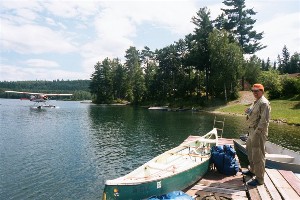 Everyone came out for the show and the proprietor, who had finallyreturned, even made an “SOS” sign to place on the lawn for the pilot tosee. Soon the same aircraft we had flown in on was pulling up to thedock. It was our former pilot, Chris, as well. We quickly loaded up,took off, and were in Tamagami within 20 minutes. I was very pleasedwhen Chris, a trained medic, examined my handiwork on Rob’s arm withapproval and asked me if I had medical training.
Everyone came out for the show and the proprietor, who had finallyreturned, even made an “SOS” sign to place on the lawn for the pilot tosee. Soon the same aircraft we had flown in on was pulling up to thedock. It was our former pilot, Chris, as well. We quickly loaded up,took off, and were in Tamagami within 20 minutes. I was very pleasedwhen Chris, a trained medic, examined my handiwork on Rob’s arm withapproval and asked me if I had medical training.
In Tamagami, we loaded up the car, changed clothes (a very difficultordeal in Rob’s case), quickly ate lunch at the local Subway, andheaded south around 3:00 p.m. on Highway 11 through constructiontraffic. As usual, I was having a difficult time transitioning tocivilization plus I was having a physical and psychological letdownafter pushing so hard with so much intensity over the past 2 days. Whenwe arrived in North Bay, I took Rob to the emergency room at the localhospital where he was examined and x-rayed. The doctor told Rob itwould be best to keep the splint on and continue on home as long as hecould see an orthopedist within 48 hours. To Rob’s surprise, I hadrecovered sufficiently to drive into the night. So, at around 7:00p.m., after a brief stop at a pharmacy, I drove on to Toronto and theneast, finally stopping after 11:30 sometime at a Quality Inn.
Friday, Aug. 11
The next day, after a heavy breakfast at the local truck stop, weheaded back. It was a long uneventful drive. I wearily pulled intoRob’s driveway around 5:00 p.m. Rob and I both agreed that this trip,although cut short and somewhat unpleasant at times, would provide agreat story for years to come. It occurs to me that Rob may try tosuppress this journal so it does not contradict any of hisembellishments. The last I heard, he was telling people that his armhad snapped while he was attempting to rescue me from an attacking bear.
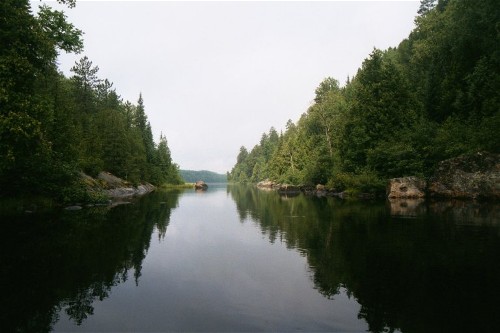
L. Walter
August 23, 2000